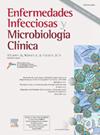Real-life experience with use of cefiderocol in non-critically ill patients in a tertiary care hospital
IF 2.5
4区 医学
Q3 INFECTIOUS DISEASES
Enfermedades infecciosas y microbiologia clinica
Pub Date : 2025-10-01
DOI:10.1016/j.eimc.2025.06.001
引用次数: 0
Abstract
Background
Clinical experience with cefiderocol is limited to a few patients with multidrug-resistant (MDR) infections. Moreover, the data has been collected primarily in critically ill patients. Thus, there is a need to increase the information regarding the use of cefiderocol in clinical practice in more types of patients.
Objectives
To evaluate the effectiveness and safety of cefiderocol in clinical practice in non-critical patients.
Methods
A retrospective observational study including all adult patients treated with cefiderocol between January 2020 and March 2023 in a tertiary hospital. Patients with a prescription at an intensive care unit were excluded. Effectiveness was measured in terms of clinical and microbiological cure seven days after the end of treatment. To assess safety, adverse effects potentially associated with cefiderocol were collected.
Results
A total of 17 patients (80% men) with a median age of 57 (IQR 53–64) years were included. The predominant focus of infection was urinary (47%). The main causal microorganism of the infection was Pseudomonas aeruginosa (59%). Eleven isolates (65%) were carbapenemase-producing gram-negative bacilli (GNB); the rest (35%) was classified as extensively-drug resistant GNB (XDR-GNB) with other resistance mechanisms. The isolated carbapenemases were one GES, one KPC, eight metallobetalactamases (seven VIM type and one NDM), and one carbapenemase without type identification. Treatment with cefiderocol was completed in all the patients. Fifteen (88%) patients were clinically cured. Regarding microbiological cure, 12 (70%) had negative cultures. No patient presented adverse effects potentially associated with cefiderocol.
Conclusion
Cefiderocol achieves clinical and microbiological improvement in non-critical patients with infections with limited therapeutic options while maintaining a good safety profile.
三级医院非危重病人使用头孢地罗的实际经验
头孢地罗的临床应用仅限于少数耐多药(MDR)感染患者。此外,这些数据主要是在危重患者中收集的。因此,有必要在更多类型的患者的临床实践中增加有关头孢地罗使用的信息。目的评价头孢地罗在非危重患者临床应用的有效性和安全性。方法回顾性观察研究,纳入2020年1月至2023年3月在某三级医院接受头孢地罗治疗的所有成年患者。在重症监护病房有处方的患者被排除在外。在治疗结束后7天,以临床和微生物治愈率来衡量有效性。为了评估安全性,收集了可能与头孢地罗相关的不良反应。结果共纳入17例患者(80%为男性),中位年龄57岁(IQR 53 ~ 64)。感染的主要部位为泌尿系(47%)。感染病原菌以铜绿假单胞菌为主(59%)。11株(65%)为产碳青霉烯酶革兰氏阴性杆菌(GNB);其余(35%)被归类为具有其他耐药机制的广泛耐药GNB (XDR-GNB)。分离到的碳青霉烯酶为1个GES、1个KPC、8个金属β -半内酰胺酶(7个VIM型和1个NDM型)和1个未分型的碳青霉烯酶。所有患者均完成头孢地罗治疗。15例(88%)患者临床治愈。在微生物治疗方面,12例(70%)为阴性培养。没有患者出现与头孢地罗相关的潜在不良反应。结论头孢地罗在治疗方案有限的非危重性感染患者中取得了临床和微生物学改善,同时保持了良好的安全性。
本文章由计算机程序翻译,如有差异,请以英文原文为准。
求助全文
约1分钟内获得全文
求助全文
来源期刊
CiteScore
2.10
自引率
8.00%
发文量
194
审稿时长
29 days
期刊介绍:
Hoy está universalmente reconocida la renovada y creciente importancia de la patología infecciosa: aparición de nuevos agentes patógenos, de cepas resistentes, de procesos con expresión clínica hasta ahora desconocida, de cuadros de una gran complejidad. Paralelamente, la Microbiología y la Infectología Clínicas han experimentado un gran desarrollo como respuesta al reto planteado por la actual patología infecciosa. Enfermedades Infecciosas y Microbiología Clínica es la Publicación Oficial de la Sociedad Española SEIMC. Cumple con la garantía científica de esta Sociedad, la doble función de difundir trabajos de investigación, tanto clínicos como microbiológicos, referidos a la patología infecciosa, y contribuye a la formación continuada de los interesados en aquella patología mediante artículos orientados a ese fin y elaborados por autores de la mayor calificación invitados por la revista.

 求助内容:
求助内容: 应助结果提醒方式:
应助结果提醒方式:


